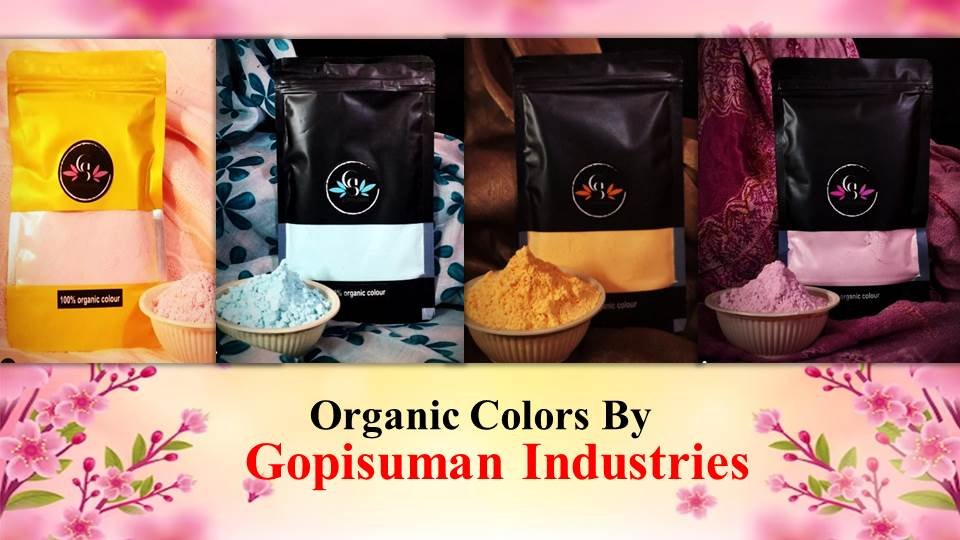How to Make Natural Colours From Flowers – Colors have always held a special place in our lives, invoking emotions, stimulating creativity, and enhancing our surroundings. While synthetic dyes dominate the market, the natural colour extract from flowers offer a captivating alternative.
extract pigment from flowers allows us to tap into nature’s vibrant palette and create eco-friendly, non-toxic colors. In this article, we will delve into the fascinating process of flowers used for making colours and dyes, providing you with an opportunity to embrace the beauty of nature and explore the world to know the flower used for making colours dyes. In this article, you will get to know about how to make natural colours from flowers.
What are Natural Colours :
Natural colours have been used for centuries in various cultural practices, art forms, and rituals. Unlike synthetic dyes, they are derived from renewable sources and are free from harmful chemicals. Using natural colors not only connects us to the environment but also promotes sustainable practices and protects our health. Whether for crafts, painting, or decorative purposes, natural colours provide a unique and earth-friendly way to infuse beauty into our lives.
Selecting Flowers for Color Extraction :
When it comes to extracting colors from flowers, various blooms offer a range of hues. Some popular choices include marigolds, roses, hibiscus, lavender, and sunflower. Each flower carries its unique pigments, presenting an array of color possibilities. It is crucial to select fresh, pesticide-free flowers to ensure the purity and vibrancy of the resulting colors. Consider growing your flower garden or sourcing blooms from organic suppliers.
Read More:
How to Extract pigment from Flowers | How to Make Natural Colours
Extraction Methods for Flower-based Pigments: The extraction of natural colors from flowers requires a careful and systematic approach to ensure optimal results. Here’s a step-by-step guide to how to extract colors from flowers:
- Flower Selection: Begin by selecting flowers that are known to yield vibrant colors. Some popular choices include marigolds (yellow/orange), hibiscus (red/pink), and butterfly peas (blue/purple). Ensure that the flowers are fresh and free from any chemical treatments or pesticides.
- Preparation:Gently wash the flowers to remove any dirt or impurities. It’s advisable to use organic and pesticide-free flowers for a truly natural and chemical-free extraction.
- Petal Separation:Carefully separate the petals from the flowers, discarding the stems and other plant parts. The petals are the primary source of natural pigments.
- Mashing or Crushing:Place the petals in a mortar and pestle or use a blender to crush them into a pulp. This helps to release the pigments from the petals and enhance the extraction process.
- Extraction Medium:Choose an appropriate medium to extract the colors from the crushed petals. Common extraction mediums include water, alcohol, or oil. Water is the most commonly used medium, as it is readily available and safe for most applications. However, certain colors may require alcohol or oil-based extraction for better solubility.
- Extraction Process:Place the crushed petals into a container and add the extraction medium, ensuring that the petals are fully submerged. Gently stir the mixture to facilitate color transfer from the petals to the medium.
- Heat or Cold Infusion:Depending on the flower and color intensity desired, you can choose to heat the mixture or allow a cold infusion. Heating the mixture on low heat for a specific duration can help enhance color extraction. Alternatively, a cold infusion method involves allowing the mixture to steep for several hours or even overnight to extract the pigments naturally.
- Straining and Filtering:Once the desired color intensity is achieved, strain the mixture to separate the liquid extract from the remaining flower pulp. Use a fine sieve or cheesecloth to filter out any solid particles, ensuring a smooth and pure color extract.
- Storage:Transfer the extracted color into a clean, airtight container for storage. Label the container with the flower source and color obtained for easy identification.

Flowers used for Making Colours | Natural Dyes from Flowers
Here are list of different Flowers used for Making Colours :
- Marigold: Collect fresh marigold flowers and remove the petals. Place the petals in a large pot with water and bring it to a gentle simmer. Allow the petals to steep for an hour, then strain the liquid. The resulting liquid can be used as a natural yellow dye.
- Rose:Pluck fresh rose petals and add them to a pot with water. Simmer the mixture on low heat for about an hour until the petals lose their color. Strain the liquid, and you’ll have a delicate pink or reddish dye.
- Hibiscus:Gather hibiscus flowers and separate the petals. Crush the petals and soak them in water overnight. Strain the liquid, and you’ll have a vibrant magenta dye.
- Lavender: Collect lavender flowers and place them in a pot with water. Simmer the mixture for about 30 minutes, then strain it. The resulting liquid will produce a calming purple hue.
- Sunflower:Crush sunflower petals and soak them in warm water for a few hours. Strain the liquid, and you’ll obtain a soft yellow dye.
Read More:
Utilization of Natural Flower based Colors
Once you have extracted the natural colours, there are numerous ways to apply and utilize them:
- Crafts and Art: Use natural dyes to create beautiful paintings, handmade paper, tie-dye fabrics, or dye yarn for knitting and weaving projects. Explore different techniques like dip-dyeing, block printing, or batik to experiment with these organic hues.
- Food and Beverages: Some natural colour derived from flowers are also safe for culinary purposes. Add a touch of natural colour to dishes, desserts, beverages, or homemade ice creams using edible flower-based dyes.
- Natural Cosmetics: Incorporate flower-based dyes into your homemade skincare and cosmetic products. Create lip balms, soaps, bath bombs, or natural hair dyes using the vibrant colors obtained from flowers.
- Natural textiles: Natural textiles offer a wonderful opportunity to incorporate eco-friendly clothing into your wardrobe. By dyeing fabrics with natural flower-based colors, you can create unique and sustainable fashion statements.
Here’s a closer look at how you can enhance your clothing with these organic hues:
Fabric Selection:
Start by selecting the fabric you wish to dye. Natural fibers like cotton, silk, linen, and hemp are excellent choices, as they absorb natural dyes more effectively than synthetic materials. These fibers also align with sustainable fashion practices, as they are biodegradable and have a lower environmental impact.
Preparing the Fabric:
Before dying, it’s essential to prepare the fabric properly. Begin by washing it thoroughly to remove any dirt, oils, or sizing agents that may interfere with the dye absorption. Follow the fabric’s care instructions and avoid using fabric softeners or detergents with brightening agents, as they can affect the dyeing process.

Pre-Treatment (Mordanting):
Some natural dyes require a pre-treatment process called mordanting to enhance color fastness and ensure the dye bonds with the fabric effectively. Mordants are substances that help fix the dye to the fabric fibers. Common mordants include alum, iron, and vinegar. Each natural dye may require specific mordants and procedures, so it’s essential to follow the recommended mordanting process for the particular flower dye you are using. This step will help the color to adhere better and increase its longevity.
Dyeing Process:
Now it’s time to dye the fabric using natural flower-based colors. Prepare the dye bath by following the extraction methods mentioned earlier in this article. Depending on the desired color intensity, you can adjust the concentration of the dye extract and the dyeing time. Ensure that the fabric is fully submerged in the dye bath and stir gently to promote even color distribution. You can experiment with various dyeing techniques, such as dip-dyeing, tie-dye, or creating patterns using resist techniques like shibori.
Heat Fixation:
After dyeing, some natural dyes require heat fixation to improve colorfastness. This process involves steaming or simmering the fabric to help set the dye. Follow the instructions specific to the dye you are using to achieve the best results. Heat fixation will ensure that the colors remain vibrant and withstand repeated washings.
Washing and Caring for Naturally Dyed Fabrics:
Once the fabric has been dyed and heat-set, it’s essential to wash it properly. Use a mild, pH-neutral detergent and cold water to gently remove any excess dye. Avoid harsh washing methods, such as vigorous scrubbing or wringing, as they can damage the fibers and fade the colors.
Line drying in a shaded area is preferable to maintain the colors’ vibrancy. Natural dyes may fade over time, especially with exposure to sunlight, so it’s best to store these garments away from direct light when not in use. By incorporating natural flower-based colors into your textile dyeing projects, you can create sustainable and beautiful garments. Each flower dye will bring its unique shade, allowing you to express your creativity and embrace a more environmentally conscious approach to fashion.
Not only will you have one-of-a-kind pieces in your wardrobe, but you’ll also contribute to reducing the environmental impact of the textile industry by choosing natural dyes over synthetic alternatives. Incorporating natural colour derived from flowers into textiles not only adds beauty to your clothing but also showcases your commitment to sustainable fashion practices.
By choosing natural textiles and dyeing them with eco-friendly colors, you contribute to reducing the environmental footprint of the fashion industry. Embrace the art of natural dyeing and create garments that are not only aesthetically pleasing but also gentle on the planet.
Fixing and Preserving Natural Colours:
To ensure the longevity of natural flower-based colors, it is essential to fix and preserve them properly. Natural dyes tend to fade over time, especially when exposed to sunlight and frequent washing. Consider using mordants, which are substances that help bind the dye to the fabric, thereby improving colorfastness. Common mordants include alum, iron, and vinegar. Follow recommended mordanting processes for each specific flower dye to achieve better color retention.
When storing natural colours, keep them in airtight containers away from direct sunlight and moisture. Label each container with the flower source and color obtained to easily identify and use them later. It’s advisable to use the colors within a reasonable timeframe to ensure their vibrancy.
Responsible and Sustainable Practices
While extracting natural colour from flowers is a sustainable and eco-friendly practice, it’s important to maintain responsible methods throughout the process. Here are a few guidelines to follow:
- Respect Nature: Harvest flowers responsibly, ensuring their sustainability and biodiversity. Avoid over-harvesting and damaging the environment.
- Water Conservation: Use water wisely during the dye extraction process. Opt for rainwater collection or reuse water from other sources whenever possible.
- Waste Reduction: Repurpose or compost leftover flower parts after dye extraction. Minimize waste by utilizing all parts of the flowers effectively.
- Conscious Consumption: Choose organic and pesticide-free flowers to ensure a clean and chemical-free color extraction process.
Conclusion:
Creating natural colour from flowers is an enchanting way to explore nature’s vibrant hues. Whether for artistic endeavors, culinary delights, or sustainable fashion, flower-based dyes offer a safe and eco-friendly alternative to synthetic colors. By embracing natural colours, we reconnect with the beauty of the natural world and promote sustainable practices. So, go ahead and embark on your journey of flower based colour extraction, allowing the vibrant pigments of nature to infuse your creations with an enchanting touch.
Read More:
- Should All Indian Farmers Shift to Organic Farming: 3 POVs
- DeHaat: Sowing the seeds of Indian Agri-Revolution
Case Studies: How using these techniques Gopisuman Industries was established
Gopisuman Industries is an emerging startup. “With the help of the aforementioned techniques utilizing flowers, Gopisuman Industries has revolutionized the industry. This emerging startup, was founded by a driven and dynamic agriculture student “Muskan Gopisuman”. Specializing in organic Holi colors, Gopisuman Industries has taken the market by storm, captivating customers and making a significant mark in the industry.
The innovative technique of deriving colors from flowers has been a key factor in Gopisuman’s triumph. By harnessing the vibrant pigments found in nature’s blooms, the company has created a range of organic Holi colors that captivate the imagination and embrace the essence of the festival. Customers have been drawn to the enchanting hues and the knowledge that these colors are free from harmful chemicals, making their Holi celebrations not only joyful but also safe and eco-conscious. company has further propelled Gopisuman Industries to new heights.
This strategic partnership has facilitated expansion into 13 states, allowing a wider audience to experience the beauty and authenticity of their products. The company’s dedication to quality and sustainability has garnered a loyal customer base, who appreciates the commitment to ethical practices and the use of natural ingredients.

As Gopisuman Industries continues to flourish, it serves as a shining example of what can be achieved through hard work, innovation, and a genuine passion for creating positive change. The company’s success story is an inspiration to aspiring entrepreneurs, demonstrating that with dedication, perseverance, and a focus on sustainable practices, one can create a thriving business while making a difference in the world.
Visit her Insta page – Gopisuman Naturals
In conclusion, Gopisuman Industries stands as a testament to the power of combining passion, innovation, and a commitment to nature-inspired products. Through their organic Holi colors and the use of flower-based techniques, they have captured the hearts and minds of customers across the nation. With an unwavering dedication to quality, sustainability, and customer satisfaction, Gopisuman Industries is poised to leave an indelible mark on the industry and inspire others to embrace the beauty of nature in all its vibrant hues.
Latest Post
- November Issue 2025- Times of Agriculture Magazine
- Punjab & Sind Bank Introduces Special Program to Support Food and Agro-Processing Sector
- Beyond Classrooms and Gardens: How a Professor Turned His Passion into Purpose
- October Issue 2025- Times of Agriculture Magazine
- Top 10 Pesticide Companies in the World
- September Issue 2025- Times of Agriculture Magazine
- Top 15 Fertilizer Companies in the World
- Top 10 Vegetable Farming Profit Per Acre in India
- August 2025 : Times of Agriculture Magazine (AgriVoltaics Farming)











